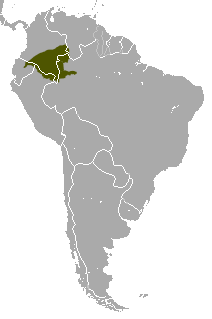Woolly monkey
Woolly Monkeys are a group of New World monkeys belonging to the genus Lagothrix. These primates are native to the South American rainforests, particularly found in countries such as Colombia, Ecuador, Peru, and Brazil. Woolly monkeys are known for their thick, woolly fur, from which their name derives. They play a significant role in their habitat's ecosystem as seed dispersers, contributing to the regeneration of the rainforest.
Description[edit | edit source]
Woolly monkeys possess a robust body, with males typically larger than females. Their fur is dense and soft, usually in shades of brown or gray. These primates have prehensile tails, which are essential for their arboreal lifestyle, allowing them to grasp and swing from tree branches effortlessly. Their diet mainly consists of fruits, but they also consume leaves, flowers, and occasionally small insects and vertebrates.
Behavior[edit | edit source]
Woolly monkeys are diurnal and primarily arboreal, spending most of their time in the upper layers of the rainforest. They live in social groups that can number from 10 to over 40 individuals, consisting of both males and females. These groups are complex and hierarchical, with a dominant male often leading. Communication within the group involves a variety of vocalizations, facial expressions, and body postures.
Conservation Status[edit | edit source]
The IUCN has classified different species of woolly monkeys as vulnerable or endangered. The main threats to their survival include deforestation due to logging and agricultural expansion, hunting for food, and the illegal pet trade. Conservation efforts are crucial to ensure the survival of these primates in their natural habitat.
Species[edit | edit source]
The genus Lagothrix includes several species and subspecies of woolly monkeys, such as:
- Lagothrix lagotricha (Humboldt's Woolly Monkey)
- Lagothrix cana (Silvery Woolly Monkey)
- Lagothrix poeppigii (Poeppig's Woolly Monkey)
- Lagothrix flavicauda (Yellow-tailed Woolly Monkey)
Each species has its unique range and characteristics, but all share the common challenges of habitat loss and hunting.
In Culture[edit | edit source]
Woolly monkeys have been part of indigenous cultures in South America, featuring in myths and folklore. However, their visibility in popular culture is minimal compared to other primates, partly due to their less widespread distribution and the threats they face in the wild.
See Also[edit | edit source]
Search WikiMD
Ad.Tired of being Overweight? Try W8MD's physician weight loss program.
Semaglutide (Ozempic / Wegovy and Tirzepatide (Mounjaro / Zepbound) available.
Advertise on WikiMD
|
WikiMD's Wellness Encyclopedia |
| Let Food Be Thy Medicine Medicine Thy Food - Hippocrates |
Translate this page: - East Asian
中文,
日本,
한국어,
South Asian
हिन्दी,
தமிழ்,
తెలుగు,
Urdu,
ಕನ್ನಡ,
Southeast Asian
Indonesian,
Vietnamese,
Thai,
မြန်မာဘာသာ,
বাংলা
European
español,
Deutsch,
français,
Greek,
português do Brasil,
polski,
română,
русский,
Nederlands,
norsk,
svenska,
suomi,
Italian
Middle Eastern & African
عربى,
Turkish,
Persian,
Hebrew,
Afrikaans,
isiZulu,
Kiswahili,
Other
Bulgarian,
Hungarian,
Czech,
Swedish,
മലയാളം,
मराठी,
ਪੰਜਾਬੀ,
ગુજરાતી,
Portuguese,
Ukrainian
Medical Disclaimer: WikiMD is not a substitute for professional medical advice. The information on WikiMD is provided as an information resource only, may be incorrect, outdated or misleading, and is not to be used or relied on for any diagnostic or treatment purposes. Please consult your health care provider before making any healthcare decisions or for guidance about a specific medical condition. WikiMD expressly disclaims responsibility, and shall have no liability, for any damages, loss, injury, or liability whatsoever suffered as a result of your reliance on the information contained in this site. By visiting this site you agree to the foregoing terms and conditions, which may from time to time be changed or supplemented by WikiMD. If you do not agree to the foregoing terms and conditions, you should not enter or use this site. See full disclaimer.
Credits:Most images are courtesy of Wikimedia commons, and templates, categories Wikipedia, licensed under CC BY SA or similar.
Contributors: Prab R. Tumpati, MD





